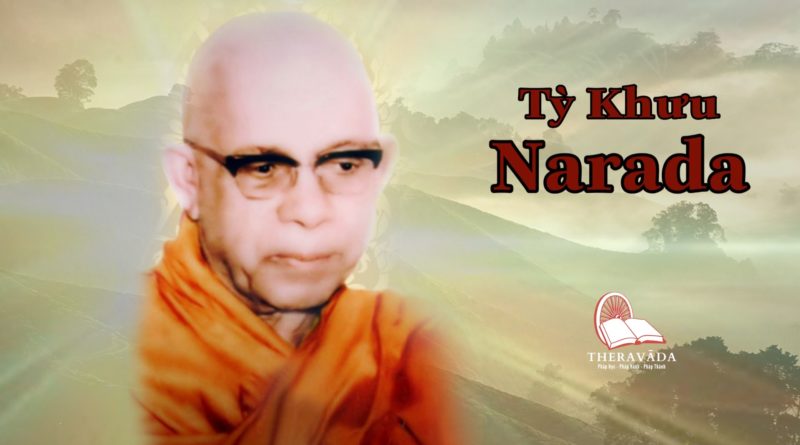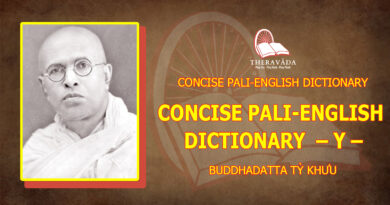Chapter Vii – Abhidhamma Categories
CHAPTER VII – Abhidhamma Categories
Samuccaya-Sangaha-Vibhāgo
§ 1. Dvāsattatividhā vuttā vatthudhammā salakkhanā
Tesam dāni yathāyogam pavakkhāmi samuccayam.
§ 2. Akusalasangaho, missakasangaho, bodhipakkhiyasangaho, sabbasangaho c’āti samuceayasangaho catubbidho veditabbo.
Katham ?
(i) Akusalasangahe tāva cattāro āsavā: – kāmāsavo, bbavāsavo, ditthāsavo, avijjāsavo.
(ii) Cattāro oghā-kāmogho, bhavogho, ditthogho, avijjogho.
(iii) Cattāro yogā-kāmayogo, bhavayogo, ditthiyogo, avijjāyogo.
(iv) Cattāro ganthā-abhijjhā kāyagantho, vyāpādo kāyagantho, sīlabbataparāmaso kāyagantho, idamsaccābhiniveso kāyagantho.
(v) Cattāro upādānā-kāmupādanm, ditthupādānam, sīlabbatupādānam, attavādupādānam.
(vi) Cha nīvaranāni – kāmachandanīvaranam, vyāpādanīvaranam, thīnamiddhanīvararnam, uddhaccakukkuccanīvaranam vicikicchānīvaranam, avijjānīvaranam.
(vii) Sattānusayā kāmarāgānusayo, bhavarāgānusayo, patighānusayo, mānānusayo, ditthānusayo, vicikicchānusayo, avijjānusayo.
(viii) Dasa samyojanāni – kāmarāgasmyojanam, rūparāgasamyojanam, arūparāgasamyojanam, patighasamyojanam, mānasamyojanam, ditthisamyojanam, sīlabbataparāmāsasamyojanam, vicikicchāsamyojanam, uddhaccasamyojanam, avijjā samyojanam, suttante.
(ix) Aparāni dasa samyojanāni-kāmarāgasamyojanam, bhavarāgasamyojanam, patighasamyojanam, mānasamyojanam, ditthisamyojanam, sīlabbataparāmā- sasamyojanam, vicikicchasamyojanam, issāsamyojanam, macchariyasamyojanam, avijjāsamyojanam, abhidhamme.
(x) Dasa kilesā-lobho, doso, moho, māno, ditthi, vtcikicchā, thīnam, uddhaccam, ahirikam, anottappam.
āsavādisu pan’ettha kāmabhavanāmena tabbatthukā tanhā adhippetā. Sīlabbataparāmāso idamsaccābhiniveso attavādupādānam ca tathā pavattam ditthigatam eva pavuccati.
āsavoghā ca yogā ca tayo ganthā ca vatthuto
Upādāna duve vuttā attha nīvaranā siyum.
Chalevānusayā honti nava samyojana matā
Kilesā dasa vutto’ yam navadhā pāpasangaho.
Abhidhamma Categories
Introductory verse
§ 1. The seventy-two kinds of entities (1) have (already) been described with their characteristics. Now I shall speak of their categories in accordance with their relations.
§ 2. The compendium of categories should be understood as fourfold:
The compendium of immoral categories.
The compendium of mixed categories
The compendium of categories that pertain to enlightenment.
The miscellaneous compendium.
(Immoral Categories)
How?
(i) To begin with, in the immoral compendium there are four Defilements (2):
1. Sense-desires, 2. Attachment to existence, 3. False Views, and 4. Ignorance.
(ii) There are four Floods (3): (same as 1-4).
(iii) There are four Bonds (4): (same as 1-4).
(iv) There are four (bodily) Ties (5): 1. Covetousness, 2. Ill will, 3. Adherence to rites and ceremonies, 4. Dogmatic belief that ‘this alone is truth’.
(v) There are four Graspings (6): 1. Sense-desires, 2. False views, 3. Adherence to rites and ceremonies, 4. Soul-theory (7).
(vi) There are six Hindrances (8): 1. to Sense-desires, 2- Ill will, 3. Sloth and Torpor, 4. Restlessness and Brooding, 5. Doubts, 6. Ignorance.
(vii) There are seven Latent Dispositions (9):
1. Attachment to sensual pleasures, 2. Attachment to existence, 3. Hatred, 4. Pride, 5. False Views, 6. Doubts, and 7. Ignorance.
(viii) There are ten Fetters according to the Suttas (10): 1. Attachment to sensual pleasures, 2. Attachment to Realms of Form, 3. Attachment to Formless Realms, 4. Hatred, 5. Pride, 6. False Views, 7. Adherence to rites and ceremonies, 8. Doubts, 9. Restlessness, and 10. Ignorance.
(ix) There are ten other Fetters according to Abhidhamma: 1. Attachment to sensual pleasures, 2. Attachment to existence, 3. Hatred, 4. Pride, 5. False Views, 6. Adherence to rites and ceremonies, 7. Doubts, 8. Envy, 9. Avarice, and 10. Ignorance.
(x) There are ten Impurities (11): 1. Greed, 2. Hate, 3. Delusion, 4. Pride, 5. False Views, 6. Doubts, 7. Sloth, 8. Restlessness, 9. Moral Shamelessness, and 10. Moral Fearlessness (unscrupulousness).
Herein in the category of Defilements and so on the terms ‘attachment to sensual pleasures’ and ‘attachment to existence’ imply craving based on them. In the same way ‘adherence to rites and ceremonies’, dogmatic belief that ‘this alone is truth’, and ‘clinging to the soul-theory’ connote just ‘false views’ connected therewith.
Summary
Actually Defilements, Floods, Bonds, and Ties are threefold. There are two Graspings and eight Hindrances. Latent Dispositions are six. Fetters should be understood as nine. Impurities are ten. This compendium of immoral categories (12) is ninefold.
Note:
1. Vatthudhammā – namely, 72. (1+52 +18 +1=72)
a. 1 – All the 89 types of consciousness are regarded as one as they all possess the characteristic of ‘awareness’.
b. 52 – All mental states (cetasikas) are viewed separately as they possess different characteristics.
c. 18 – All the conditioned (nipphanna) rūpas are considered separately since they differ in their characteristics.
d. 1 – Nibbāna is one inasmuch as it possesses the characteristic of peacefulness.
All these 72 are subjective and objective realities described in the previous chapters. They are miscellaneously treated in this chapter.
2. āsava is derived from ā + Ö su, to flow. They are so called either because they flow up to the topmost plane of existence or because they persist as far as the gotrabhū consciousness (i.e., the thought-moment that immediately precedes the Path-consciousness of the ‘Stream-winner’ – sotāpatti). These āsavas are latent in all worldlings and may rise to the surface in any plane of existence. They lie dormant in all from an indefinite period and are treated as strong intoxicants or drugs that infatuate beings. Defilements, Corruptions, Depravities, Taints, Intoxicants, Stains, are suggested as the closest equivalents for this ‘infamously famous’ Pāli term. See Compendium p. 170, n. 1; p. 227.
Of the four āsavas, kāmāsava means attachment to sensual pleasures, bhavāsava is attachment to rūpa and arūpa planes of existence, ditthāsava are the sixty-two kinds of erroneous views, (see Digha Nikāya 1) and avijjāsava is ignorance with regard to the four Noble Truths, past life, future life, both past and future lives, and the Law of Dependent Arising.
3. Ogha is derived from ava + Ö han, to harm or kill. Beings caught in the current of a great flood are overturned and swept away directly to the sea and are hurled into the bottom. In the same way these oghas drown beings completely and sweep them away into states of misery.
4. Yoga is derived from Ö yuj, to yoke. Yogas are those that yoke beings to the round of existence or to the machine of existence.
5. Ganthas are those that bind mind with body or the present body with bodies of future existences. Here the term kāya is used in the sense of mass or body both mental and physical.
6. Upādānāni is derived from upa + ā Ö dā, to give. Intense craving is implied by the term. Hence in the paticcasamuppāda it is stated: Because of craving (tanhā) there is attachment or grasping (upādāna).Tanhā is like a thief groping in the dark to steal some thing. Upādāna is like the actual stealing.
7. Attavādūpādāna – Commentaries mention twenty kinds of soul-theories associated with the five Aggregates as follows:
(i) Soul is identical with the body,
(ii) Soul is possessed of a body,
(iii) Soul is in the body,
(iv) Body is in the soul.
Four soul-theories connected with each of the remaining four Aggregates should be similarly understood.
8. Nīvaranāni – is derived from nī + Ö var, to obstruct, to hinder. They are so called because they obstruct the way to celestial and Nibbānic bliss. According to the commentary this term means that which prevents the arising of good thoughts in the way of jhānas, etc., or that which does not allow the jhānas to arise, or that which obstructs the eye of wisdom. See A Manual of Buddhism, pp. 113-115, and The Buddha and His Teachings, pp. 539-542.
Usually nīvaranas are regarded as five, excluding ignorance.
Both sloth and torpor, restlessness and brooding, are grouped together because their functions (kicca), causes (āhāra = hetu), and their opposing factors are similar. The function of sloth and torpor is mental inactivity; that of restlessness and brooding is disquietude. The cause of the first pair is laziness; that of the second pair is vexation about the loss of relatives, etc. Energy is opposed to the first pair; tranquillity, to the second pair.
Sense-desire is compared to water mixed with various colours; ill will, to boiling water; sloth and torpor, to water covered with moss; restlessness and brooding, to perturbed water caused by wind; indecision, to turbid and muddy water.
Just as one cannot perceive one’s own reflection in muddy water, even so when one is obsessed by Hindrances one cannot perceive what is conducive to the good and happiness of oneself and others.
These Hindrances are temporarily inhibited by the jhānas. They are completely eradicated by attaining, the four stages of Sainthood. Doubt or indecision is eradicated by attaining sotāpatti; sense-desire, ill will and brooding, by attaining Anāgāmi; sloth, torpor, and restlessness by Arahatta.
9. Anusaya, derived from anu + si, to lie, to sleep, are those that lie dormant in oneself until an opportune moment arises for them to come to the surface as they have not been eradicated. All passions are anusayas; but these seven are the strongest. Every worldling who has reached the topmost jhāna plane, when born amongst mankind, may give vent to these evil tendencies as they are latent in him.
10. Samyojana – from sam + Ö yuj, to yoke, to bind, are those which bind beings to the round of existence. By means of the four Paths (magga) they are eradicated by degrees. See Ch. 1.
11. Kilesas are those which defile or torment the mind.
12. In the categories of evil the term kāma is at times applied to kāma-sphere, and bhava to both rūpa and arūpa spheres. Lobha is implied by both kāma-tanhā and bhava-tanhā. Attachment to rūpa and arūpa-spheres is bhava-tanhā. The three terms – sīlabbataparāmāsa (indulgence in rites and ceremonies), idamsaccābhinivesa (the dogmatic belief that this alone is truth) and attavādūpādāna (soul-theory) – connote ditthi (false view, or error). Both kāmāsava and bhavāsava connote lobha. Strictly speaking, there are only three āsavas, oghas, yogas, and ganthas. Similarly there are only two upādānas by way of lobha and ditthi.
When the two pairs – thīna-middha and uddhacca-kukkucca – are treated as four mental states, nīvaranas amount to eight. When kāmarāga and bhavarāga are grouped in craving, anusayas amount to six. The ten samyojanas, according to Suttanta, are reduced to seven when kāmarāga, rūparāga, arūparāga are included in lobha, and ditthi and sīlabbataparāmāsa in ditthi. The ten samyojanas are treated as eight when kāmarāgaand bhavarāga are included in lobha, and ditthi and sīlabbataparāmāsa in ditthi. Kilesas are precisely ten. Thus, it will be seen, that the 14 immoral mental states appear in different proportions in the nine categories of evil. Lobha is common to all.
Diagram XIV
|
ā s a v a |
o g h a |
y o g a |
g a n t h a |
u
p ā d ā n a |
nī
v a r a n a |
a
n u s a y a |
sa
m y o j a n a |
k i l e s a |
||
| 1. lobha (tanhā)-craving | 9 |
+ |
+ |
+ |
+ |
+ |
+ |
+ |
+ |
+ |
| 2. ditthi – False View, Error | 8 |
+ |
+ |
+ |
+ |
+ |
+ |
+ |
+ |
|
| 3. avijjā (moha) – Ignorance | 7 |
+ |
+ |
+ |
+ |
+ |
+ |
+ |
||
| 4. patigha (dosa) – Ill will, Hatred | 5 |
+ |
+ |
+ |
+ |
+ |
||||
| 5. vicikicchā (kankhā) – Doubt, Indecision | 4 |
+ |
+ |
+ |
+ |
|||||
| 6. māna – Pride, Conceit | 3 |
+ |
+ |
+ |
||||||
| 7. uddhacca – Restlessness | 3 |
+ |
+ |
+ |
||||||
| 8. thīna – Sloth | 2 |
+ |
+ |
|||||||
| 9. kukkucca – Brooding | 1 |
+ |
||||||||
| 10. middha – Torpor | 1 |
+ |
+ |
|||||||
| 11. ahirika – Moral Shamelessness | 1 |
+ |
||||||||
| 12. anottappa – Moral Fearlessness | 1 |
+ |
||||||||
| 13. issā – Jealousy, Envy | 1 |
+ |
||||||||
| 14. macchariya – Avarice | 1 |
Missaka-Sangaho
§ 3.
(i) Missaka-sangahe cha hetu – lobho, doso, moho, alobho, adoso, amoho
(ii) Sattajhānangani-vitakko, vicāro, pīti, ekaggatā, somanassam, domanassam, upekkhā.
(iii) Dvādasamaggangani – sammāditthi, sammāsankappo, sammāvācā, sammākammanto, sammājīvo, sammāvāyāmo, sammāsati, sammāsamādhi, micchāditthi, micchāsankappo, micchāvāyāmo, micchāsamādhi.
(iv) Bāvīsatindriyāni – cakkhundriyam, sotindriyam, ghānindriyam, jivhindriyam, kāyindriyam, itthindriyam, purisindriyam, jīvitindriyam, manindriyam, sukhindriyam, dukkhindriyam, somanassindriyam, domanassindriyam, upekkhindriyam, saddhindriyam, viriyindriyam, satindriyam, samādhindriyam, paññindriyam, anaññātassāmītindriyam, aññindriyam, aññātāvindriyam.
(v) Navabalāni – saddhābalam, viriyabalam, satibalam, samādhibalam, paññābalam. hiribalam, ottappabalam, ahirikabalam, anottappabalam.
(vi) Cattāro adhipati – chandādhipati, viriyādhipati, cittādhipati, vimamsādhipati.
(vii) Cattāro āhārā – kabalīkāro āhāro, phasso dutiyo, manosañcetanā tatiyo, viññānam catuttham.
Indriyesu pan’ ettha sotāpattimaggañānam anaññatassāmītindriyam, arahattaphalañānam aññātāvindriyam, majjhe cha ñānani aññindriyānī ‘ti pavuccanti. Jīvitindriyañ ca rūpārūpavasena duvidham hoti. Pañcaviññanesu jhānangāni, aviriyesu balāni, ahetukesu maggarigāni na labbhanti. Tathā vikicchācitte ekaggatā maggindriyabalabhāvam na gacchati. Dvihetuka tihetukajavanesv’ eva yathāsambhavam adhipati eko’ va labbhati.
Cha hetu pañca jhānanga maggangā nava vatthuto
Solasindriyadhammā ca baladhamma nav’ eritā.
Cattārodhipati vuttā tathāhāra’ ti sattadhā
Kusalādisamākinno vutto missakasangaho.
Mixed Categories
§ 3. In the compendium of mixed categories (13):
(i) There are six Roots (14): 1. Greed, 2. Aversion, 3. Delusion, 4. Non-attachment, 5. Goodwill, and 6. Wisdom.
(ii) There are seven constituents of jhāna (15): 1. Initial Application, 2. Sustained Application, 3. Joy, 4. One-pointedness, 5. Pleasure, 6. Displeasure, and 7. Equanimity or Indifference.
(iii) There are twelve constituents of the Path (16): 1. Right Understanding, 2. Right Thoughts, 3. Right Speech, 4. Right Action, 5. Right Livelihood, 6. Right Effort, 7. Right Mindfulness, 8. Right Concentration, 9. Wrong Views, 10. Wrong Thoughts, 11. Wrong Effort, 12. Wrong one-pointedness.
(iv) There are twenty-two Faculties (17): 1. Eye, 2. Ear, 3. Nose, 4. Tongue, 5. Body, 6. Femininity, 7. Masculinity, 8. Vitality, 9. Mind, 10. Happiness, 11. Pain, 12. Pleasure, 13. Displeasure, 14. Equanimity, 15. Confidence, 16. Effort, 17. Mindfulness, 18. Concentration, 19. Wisdom, 20. The thought: ‘I will realize the unknown’, 21. Highest Realization, 22. The Faculty of him who has fully realized.
(v) There are nine Powers (18): 1. Confidence, 2. Energy, 3. Mindfulness, 4. Concentration, 5. Wisdom, 6. Moral shame, 7. Moral dread, 8. Moral Shamelessness, 9. Moral Fearlessness.
(vi) There are four Dominating Factors (19): 1. Intention (or Wish-to-do), 2. Energy (or Effort), 3. Mind (or Thought) (20), and 4. Reason (or Intellect).
(vii) There are four kinds of Food (21): 1. Edible Food, 2. Contact (or sense-impact), 3. Volitional activities, and 4. (Rebirth) Consciousness.
Now, amongst the Faculties, the thought, ‘I will realize the unknown’ means the knowledge of the Path of the Stream-Winner (Sotāpanna). The Faculty of him who has fully realized, means the knowledge of the Fruit of Arahatship. Highest Realization means the intermediate six kinds of knowledge. The controlling Faculty of vitality is twofold, physical and mental.
The jhāna constituents (22) are not obtained in the five kinds of sense-cognition; ‘Forces’, in effortless states (23); ‘the Path Constituents’, in the Rootless(24). Similarly in the consciousness accompanied by Doubts (25), one-pointedness does not attain to the state of a ‘Path Constituent’, ‘Controlling Faculty’ or a ‘Force’. Only one ‘Dominating Power’ (26) is obtained at a time, according to circumstances, and only in the javanaconsciousness, accompanied by two or three moral roots.
Summary
In reality six roots, five jhāna constituents, nine Path constituents, sixteen controlling factors, nine powers have been described (27).
Likewise four dominant factors, and four kinds of food have been told. Thus in seven ways has the compendium of mixed categories, consisting of moral and immoral states, been enumerated.
Notes:
13. Missakasangaho – This is so called because moral (kusala), immoral (akusala), and indeterminate (avyākata), are mixed in this section.
14. Hetu – See Chapter 1, p. *.
15. Jhānanga – Jhāna is explained as that which burns up the opposing conditions of Hindrances, or that which closely perceives the object. Both these meanings are applicable to the ecstasies, gained by mental concentration. The six constituents of jhāna are used in these two senses. When the same factors appear in a moral or immoral consciousness and ‘displeasure’ appears in an immoral consciousness, they are termed jhānangas in the second general sense. Only displeasure is immoral; the rest are moral, immoral, and indeterminate. See Chapter 1.
16. Maggangāni – Here magga is used in its general sense namely, that which leads to the presence of blissful states, woeful states, and Nibbāna (sugati-duggatīnam nibbānassa ca abhimukham pāpanato maggā – Comm.). Of the twelve constituents the last four lead to woeful states; the rest, to the blissful states and Nibbāna.
Strictly speaking, by these twelve constituents are meant nine mental states found in different types of consciousness. Of the four evil constituents, wrong views mean the immoral ditthi cetasikā; wrong thoughts, wrong effort, and wrong one-pointedness mean the vitakka, vāyāma, and ekaggatā cetasikās respectively found in the immoral types of consciousness.
Right Understanding means the paññā cetasika; right thoughts, right effort, right mindfulness, and right one-pointedness mean the vitakka, vāyāma, sati and ekaggatā cetasikas respectively, found in the moral and indeterminate types of consciousness. Right speech, right action, and right livelihood are the three Abstinences (virati) found collectively in the supramundane consciousness and separately in mundane moral types of consciousness. The first eight are collectively found only in the eight types of supramundane consciousness. By the noble Eightfold Path are meant these eight specific mental states.
17. Indriya – So called because they possess a controlling power in their respective spheres. The first five are the sensitive organs described earlier. The sixth and seventh are collectively called bhāvindriya. Vitality is both physical and mental. 10, 11, 12, 13, and 14 represent five kinds of feeling. 15,16,17,18, and 19 are treated both as Faculties and Powers as they influence their co-adjuncts and as they overcome their opposing forces. The last three Faculties are very important and they pertain to the supramundane. By anaññātam is meant the Nibbāna never seen before. It is at the first stage of Sainthood (sotāpatti) that the four Truths are realized for the first time. Hence the knowledge of the sotāpatti Path is technically called anaññātam ñassāmi’t’indriyam. The intermediate six kinds of knowledge from the sotāpatti Fruit to the Arahatta Path are termed aññā (derived from ā= perfect + Ö ñā, to know), highest knowledge. As the wisdom found in all these seven types of supramundane consciousness controls the coexisting 37 Factors of Enlightenment, it is termed indriya. An Arahat is called an aññātāvī because he has fully realized the four Noble Truths. The last Faculty refers to the highest knowledge of the Arahat in the Fruit stage.
18. Balāni – These nine Powers are so called because they cannot be shaken by the opposing forces and because they strengthen their co-adjuncts. The first seven are moral; the last two, immoral. The first seven, in order, are opposed to faithlessness, laziness, heedlessness, restlessness, ignorance, moral shamelessness, and moral fearlessness. The last two immoral Powers are found only in the immoral twelve types of consciousness and they consolidate their co-adjuncts.
19. Adhipati, lit., supremacy, or lordship therein. The difference between adhipati and indriya should be clearly understood. Adhipati may be compared to a king who, as the sole head of the State, lords over all his ministers. Indriyas are compared to the king’s ministers who control only their respective departments without interfering with the others. The Faculty of eye, for instance, controls only its coexisting rūpas without any interference with the controlling faculty of the ear. In the case of adhipati, one dominates all the other coexisting factors with no resistance from any. No two adhipatis can exercise supreme authority simultaneously. Indriyas can have their compeers.
20. Here citta refers to the javana thought-process and vimamsā to the faculty of wisdom (paññindriya).
21. āhāra, in this connection, is used in the sense of sustenance. Edible food (kabalīkārāhāra) sustains the material body. Phassāhāra or contact or sense-impact sustains the five kinds of feeling. By manosamcetanāhāraare meant the different kinds of volitions present in the 29 types of moral and immoral mundane consciousness. They sustain or produce rebirth in the three spheres. Viññānāhāra signifies the rebirth-consciousness that sustains the mental states and material phenomena (nāma-rūpa) which arise simultaneously. There are 19 such types of rebirth-consciousness. In the case of Mindless Spheres they sustain only rūpa; in the case of Formless Spheres they sustain only nāma. In the existences where the five Aggregates are present they sustain both mind and matter.
22. No jhāna constituents are present in the 10 types of sense-cognitions because the sense-impressions are weak, and close perception of the object is absent.
23. Effortless states are the sixteen types of consciousness, namely, ten sense-cognitions, two sampaticchanas, three santīranas, and the sense-door consciousness (pañcadvārāvajjana). One-pointedness present in them is not very strong.
24. The Rootless are the 18 ahetuka-cittas.
25. The one pointedness present in the vicikicchā-citta serves only to stabilize the mind. It is not powerful.
26. There are no adhipatis in the ahetuka and ekahetuka cittas.
27. Strictly speaking, there are five jhāna constituents because the three kinds of feeling could be treated as one; path constituents are nine, since wrong thoughts, effort, and one-pointedness are included in vitakka, viriyaand ekaggatā respectively. Indriyas are sixteen when the five kinds of feelings are grouped in one, and the three supramundane in paññā.
Bodhipakkhiya Sangaho
§ 4.
i. Bodhipakkhiyasangahe cattāro satipatthānā-kāyānupassanā-satipatthānam, vedanānupassanā-satipatthānam, cittānupassanā-satipatthānam, dhammānupassanā-satipatthānam.
ii. Cattāro sammappadhānā – uppannānam pāpakānam pahānāya vāyāmo, anuppannānam pāpakānam anuppādāya vāyāmo, anuppannānam kusalānam uppādāya vāyāmo, uppannānam kusalānam bhiyyobhāvāya vāyāmo.
iii. Cattāro iddhipādā – chandidhipādo, viriyiddhipādo, cittiddhipādo, vīmamsiddhipādo.
iv. Pañcindriyāni – saddhindriyam, viriyindriyam, satindriyam, samādhindriyam, paññindriyam.
v. Pañcabalāni – saddhābalam, viriyabalam, satibalam, samādhibalam, paññābalam.
vi. Sattabojjhangā – satisambojjhango, dhammavicayasambojjhango, viriyasambojjhango, pītisambojjhango, passaddhisambojjango, samādhisambojjhango, upekkhāsambojjhango.
vii. Atthamaggangāni – sammāditthi, sammāsankappo, sammāvācā, sammākammanto, sammājīvo, sammāvāyāmo, sammāsati, sammāsamādhi.
Ettha pana cattāro satipatthānā’ti sammā-sati ekā’va pavuccati. Tathā cattāro sammappadhānā’ti ca sammāvāyāmo.
Chando cittam upekkhā ca saddhā-passaddhi-pītiyo
Sammāditthi ca sankappo vāyāmo viratittayam
Sammāsati samādhī’ti cuddas’ete sabhāvato
Sattatimsappabhedena sattadhā tattha sangaho.
Sankappa-passadhi ca pītupekkhā chando ca cittam viratittayañ ca
Nav’ekathānā viriyam nava’attha sati samādhi catu, pañca paññā.
Saddhā duthānuttamasatta-timsaddharnmānam’eso pavaro vibhāgo
Sabbe lokuttare honti na vā samkappapītiyo
Lokiye’pi yathāyogam chabbisuddhippavattiyam.
Factors of Enlightenment (28)
§ 4. In the compendium of Factors pertaining to Enlightenment:-
i. There are four Foundations of Mindfulness (29): 1. Mindfulness as regards body, 2. Mindfulness as regards feelings, 3. Mindfulness as regards thoughts, 4. Mindfulness as regards Dhamma.
ii. There are four Supreme Efforts (30): 1. The effort to discard evils that have arisen, 2. The effort to prevent the arising of unrisen evils, 3. The effort to develop unrisen good, 4. The effort to augment arisen good.
iii. There are four Means of Accomplishment (31): 1. Will, 2. Effort, 3. Thought, 4. Reason.
iv. There are five Faculties (32): 1. Confidence, 2. Effort, 3. Mindfulness, 4. Concentration, 5. Wisdom.
v. There are five Powers (32): 1. Confidence, 2. Effort, 3. Mindfulness, 4. Concentration. 6. Wisdom.
vi. There are seven Constituents of Enlightenment (33): 1. Mindfulness, 2. Investigation of the Truth, 3. Effort, 4 Rapture, 5. Quietude, 6. Concentration, 7. Equanimity.
vii. There are eight Path Constituents (34): 1 Right Understanding, 2. Right Thoughts, 3. Right Speech, 4. Right Action, 5. Right Livelihood., 6. Right Effort, 7. Right Mindfulness, 8. Right Concentration.
Here by the four Foundations of Mindfulness, Right Mindfulness alone is implied. Right Effort is implied by the four Supreme Efforts.
The sevenfold compendium which consists of 37 factors, is composed of these fourteen according to their nature: Will, Thought, Equanimity, Confidence, Quietude, Rapture, Right Understanding, Aspirations or Thoughts, Effort, the three Abstinences, Right Mindfulness, and Concentration.
The enumeration of these 37 sublime factors is as follows: Aspirations, Quietude, Rapture, Equanimity, Will, Thought, the three Abstinences, occur once; Effort nine times; Mindfulness eight times; Concentration four times; Wisdom five times; Confidence twice (35).
All these, save at times Aspirations and Rapture, occur in the Supramundane (Consciousness) and in the mundane (consciousness) too, according to circumstances, in the course of sixfold purity.
Notes:
28. Bodhipakkhiya – Bodhi means Enlightenment or the aspirant for Enlightenment. Pakkhiya, literally, means ‘on the side of’.
29. Satipatthāna – sati = mindfulness, awareness, or attentiveness; patthāna = establishment, application, foundations, bases. These satipatthānas are intended to develop both concentration and insight. Each satipatthānaserves a specific purpose. Contemplation on these four leads, on the one hand, to the development of ‘undesirableness’ (asubha), painfulness (dukkha), impermanence (anicca), and ‘soullessness’ (anattā); and, on the other hand, to the eradication of ‘desirableness’, pleasure, permanence and substantiality.
Briefly, the objects of mindfulness may be divided into nāma and rūpa. The first – which deals with rūpa, breath is also regarded as a kind of rūpa. The second and the third deal with different kinds of feelings and thoughts. The fourth deals with both nāma and rūpa. Hence it is very difficult to render the Pāli term, Dhamma, used in this connection, by one English equivalent. It is preferable to retain the Pāli term to avoid any misunderstanding.
For details see the Satipatthāna Sutta and the commentary.
30. Sammappadhāna (Right exertion) – One mental state – viriya – performs four functions.
31. Iddhipāda – The means of accomplishing one’s own end or purpose. Strictly speaking, all these four pertain to the Supramundane Consciousness. Chanda is the mental state ‘wish-to-do’. Viriya refers to the four Supreme Efforts. Citta means the Supramundane Consciousness. Vīmamsā signifies the mental state of wisdom present in the Supramundane Consciousness. Only when these four are present in the Supramundane Consciousness are they termed iddhipāda.
32. Indriyas and Balas are identical though different meanings are attached to them.
33. Sambojjhanga – Sam = exalted, good; bodhi = enlightenment or one who is striving for enlightenment; anga = factor. Here dhammavicaya means seeing mind and matter as they truly are. It is insight. By passaddhi are meant both citta-passaddhi and kāya-passaddhi mental states. Upekkhā does not mean hedonic indifference but mental equipoise known as tatramajjhattatā.Dhammavicaya, viriya, and pīti are opposed to thīna-middha(sloth and torpor); passaddhi, samādhi, and upekkhā, to uddhacca (restlessness).
34. Maggangāni – According to the commentaries, here magga is used in two different senses, namely, ‘that which is sought by those who strive for Nibbāna’, or ‘that which goes by killing the passions’ (nibbānatthikehi maggīyatī’ti vā kilese mārento gacchatī’ ti maggo). Evidently this particular definition has been given to differentiate the noble Eightfold Path from an ordinary one.
Strictly speaking, these eight factors connote eight mental states collectively found in the supramundane consciousness that has Nibbāna for its object.
Sammā-ditthi is rendered by Right Understanding, Right Views, Right Beliefs, Right Knowledge. Sammā-ditthi is explained as the knowledge of the four Noble Truths. In other words, it is the understanding of one’s personality as it really, is or of things as they truly are. According to Abhidhamma, it is the mental state of wisdom (paññā) that tends to eradicate ignorance (avijjā). It is placed first because all actions should be regulated by wisdom. Right Understanding leads to Right Thoughts.
Sammā-sankappa is rendered by Thoughts, Aspirations, Intentions, Ideas. According to Abhidhamma it is the mental state of vitakka (application) that directs the mind to Nibbāna, eliminating the evil thoughts of sense-desires (kāma), ill will (vyāpāda) and cruelty (himsā), by cultivating the good thoughts of renunciation (nekkhamma), loving-kindness (avyāpāda), and harmlessness (avihimsā).
The first two constituents are grouped in wisdom (paññā).
Right Thoughts lead to Right Speech, Right Action, and Right Livelihood. These three constitute sīla or Morality.
Sammā-vācā signifies abstinence from lying, slandering, harsh speech, and frivolous talk.
Sammā-kammanta deals with abstinence from killing, stealing, and misconduct.
Sammā-jīva is twofold. It deals with right livelihood of both Bhikkhus and laymen. The latter are prohibited from trading in arms, slaves, intoxicants, animals for slaughter, and poison.
The three mental states of ‘Abstinences’ (virati) are implied by these three constituents.
Sammā-vāyāma signifies the four Supreme Efforts mentioned above.
Sammā-sati denotes the four kinds of Mindfulness mentioned above.
Sammā-samādhi is concentration or the ‘one pointedness of the mind’. It is the mental state of ‘ekaggatā’.
The last three are included in samādhi or concentration.
The eight constituents comprise Morality, Concentration, and Wisdom or Insight.
35. Effort (viriya) occurs nine times as follows:
4 Supreme Efforts, 1 Means of Accomplishment, 1 Controlling Factor, 1 Power, 1 Constituent of Enlightenment, 1 Right Effort.
Mindfulness (sati) occurs eight times as follows:
4 Foundations of Mindfulness, 1 Controlling Factor; 1 Power, 1 Constituent of Enlightenment, 1 Right Mindfulness.
Concentration (samādhi) occurs four times as follows:
1 Controlling Factor, 1 Power, 1 Constituent of Enlightenment, and 1 Right Mindfulness.
Wisdom (paññā) occurs five times as follows:
1 Means of Accomplishment, 1 Controlling Factor 1 Power, 1 Constituent of Enlightenment, and 1 Right Understanding.
Confidence (saddhā) occurs twice as follows:
1 Controlling Factor, 1 Power.
When the Supramundane Consciousness based on the second jhāna is gained, there is no vitakka. When it is gained based on the fourth and fifth jhānas, there is no pīti.
These 37 factors are collectively found only in the Supramundane Consciousness, but in the mundane separately according to the type of consciousness.
Diagram III
???
Sabbasangaho
§ 5.
(i) Sabbasangahe – Pañcakkhandho, rūpakkhandho, vedanākkhandho, saññākkhandho, sankhārakkhandho, viññānakkhandho.
(ii) Pañcupādānakkhandhā – rūpupādānakkhandho, vedanūpādānakkhandho, saññūpādānakkhandho, sankhārūpādānakkhandho, viññānupādānakkhandho.
(iii) Dvādasāyatanāni – cakkhāyatanam, sotāyatanam ghānāyatanam, jivhāyatanam, kāyāyatanam, manāyatanam, rūpāyatanam, saddāyatanam, gandhāyatanam, rasāyatanam, photthabbāyatanam, dhammāyatanam.
(iv) Atthārasadhātuyo – cakkhudhātu, sotadhātu, ghānadhātu, jivhādhātu, kāyadhātu, rūpadhātu, saddadhātu, gandhadhātu, rasadhātu, photthabbadhātu cakkhuviññānadhātu, sotaviññānadhātu, ghānaviññānadhātu, jivhāviññānadhātu, kāyaviññānadhātu, manodhātu, dhammadhātu, manoviññānadhātu.
(v) Cattāri ariyasaccāni – dukkham ariyasaccam, dukkhasamudayo ariyasaccam, dukkhanirodho ariyasaccam, dukkhanirodhagāminipatipadā ariyasaccam.
Ettha pana cetasikā-sukhumarūpa-nibbānavasena ekūnasatti dhammā dhammāyatanadhammadhātū’ti sankham gacchanti. Manāyatanam eva sattaviññānadhātu vasena bhijjati.
1. Rupañ ca vedanā saññā sesā cetasikā tathā
Viññānam iti pañc’ete pañcakkhandhā’ti bhasitā.
2. Pañc’ upādānanakkhandhā’ti tathā tebhumakā matā
Bhedābhāvena nibbānam khandhasangaha-nissatam.
3. Dvārālambanabhedena bhavantāyatanāni ca
Dvārālambataduppannapariyāyena dhātuyo
4. Dukkham tebhūmakam vattam tanhāsamudayo bhave
Nirodho nāma nibbānam maggo lokuttaro mato.
5. Maggayuttā phalā c’eva catusaccavinissatā
Iti pañcappabhedena pavutto sabbasangaho.
Iti Abhidhammatthasangahe samuccayasangahavibhāgo nāma sattamaparicchedo.
A Synthesis of ‘the Whole’ (36)
§ 5. In the compendium of ‘the whole’ there are:
(i) The Five Aggregates (37):
1. matter, 2. feeling, 3. perception, 4. mental states (38), 5. consciousness.
(ii) The Five Aggregates of Grasping (39):
1. matter, 2. feeling, 3. perception, 4. mental states, 5. consciousness.
(iii) The Twelve Spheres (40):
(a) Sense-Organs
1, eye (41), 2. ear, 3. nose, 4. tongue, 5. body, 6. mind (42).
(b) Sense-Objects
7. visible object, 8. sound, 9. odour, 10. taste, 11. tangible object, 12. cognizable object.
(iv) The Eighteen Elements (43):
1. eye, 2. ear, 3. nose, 4. tongue, 5. body, 6. visible object, 7. sound, 8. odour, 9. taste, 10. tangible object, 11. eye-consciousness, 12. ear-consciousness, 13. nose-consciousness, 14. tongue-consciousness, 15. body-consciousness, 16. mind, 17. cognizable object (44), 18. mind-consciousness (45).
(v) The Four Noble Truths (46):
1. the Noble Truth of Suffering, 2. the Noble Truth of the Cause of Suffering, 3. the Noble Truth of the Cessation of Suffering, 4. the Noble Truth of the Path leading to the Cessation of Suffering.
Herein sixty-nine entities comprising 52 mental states, 16 subtle matter, and Nibbāna, are regarded as the sphere of cognizables and the cognizable element. Only the sphere of mind divides itself into seven consciousness-elements.
Summary
Matter, feeling, perception, remaining mental states, and consciousness – these five are called the five Aggregates.
Similarly those that pertain to the three planes are regarded as Five Aggregates of grasping.
As Nibbāna lacks differentiation (such as past, present, future) it is excluded from the category of Aggregates.
Owing to the difference between doors and objects there arise (twelve) sense-spheres. In accordance with doors, objects, and their resultant consciousness arise the elements.
Existence in the three planes is suffering. Craving is its cause. Cessation is Nibbāna. Path is regarded as supramundane.
Mental states associated with the Paths and the Fruits are excluded from the four Truths.
Thus the category of ‘the whole’ has been explained in five ways.
This is the seventh chapter of the Compendium of Abhidhamma dealing with the Abhidhamma Categories.
Notes:
36. Category of all such as Aggregates, etc.
37. Khandha means group, mass, aggregate. The Buddha analyses the so-called being into five groups. All the past, present, and future material phenomena are collectively called rūpakkhandha. The other four divisions should be similarly understood.
38. Here the term Sankhāra is used in a specific sense. Of the 52 mental states, feeling is one, and perception is another. The remaining 50 mental states are collectively called sankhāra. Mental formations, propensities, tendencies, syntheses, do not exactly convey the meaning of the Pāli term. Even ‘volitional activities’ is not very appropriate.
‘Mental states’ is too general, but is not misleading.
39. Upādānakkhandha. They are so called because they form the objects of clinging or grasping. The eight supramundane states of consciousness and mental states found therein, and the ten material qualities not born of Kamma. are not treated as upādānakkhandha.
40. āyatana means a field, sphere, basis.
41.Cakkhāyatana means the sensitive part of the eye which responds to visual stimuli. The four remaining sense-organs should be similarly understood.
42. Manāyatana – There is no special organ for the mind like the physical organs. By mind-sphere is meant the ‘adverting consciousness’ (manodvārāvajjana) together with the preceding ‘arrest bhavanga’(bhavangupaccheda). See Chapter 1.
43. Dhātu is that which bears its own characteristic.
44. Dhamma-dhātu is synonymous with dhammāyatana but differs from dhammārammana as it does not include citta (consciousness), paññatti (concepts), and pasāda-rūpas (sensitive material phenomena).
45. Manoviññānadhātu – Of the 89 classes of consciousness 76 types of consciousness are regarded as mind-consciousness, excluding the tenfold sense-consciousness (dvipañcaviññāna) and the three manodhātu (= two types of receiving-consciousness and sense-door consciousness).
46. Ariyasacca – The Pāli term for truth is sacca which means that which is. Its Sanskrit equivalent is satya which denotes an incontrovertible fact. The Buddha enunciates four such truths which are associated with so-called beings. They are called ariyasaccānī because they were discovered by the Greatest Ariya, the Buddha, who was far removed from passions .
The first truth deals with dukkha which, for need of a better English equivalent, is inappropriately rendered by suffering or sorrow. As a feeling dukkha means that which is difficult to endure. As an abstract truth dukkha is used in the sense of contemptible (du) emptiness (kha). The world rests on suffering – hence it is contemptible. It is devoid of any reality – hence it is empty or void. Dukkha, therefore, means contemptible void.
The cause of this suffering is craving or attachment (tanhā) which leads to repeated births. The third Noble Truth is Nibbāna which can be achieved in this life itself by the total eradication of all forms of craving. The fourth Truth is the Noble Eightfold Path or the Middle Way.








